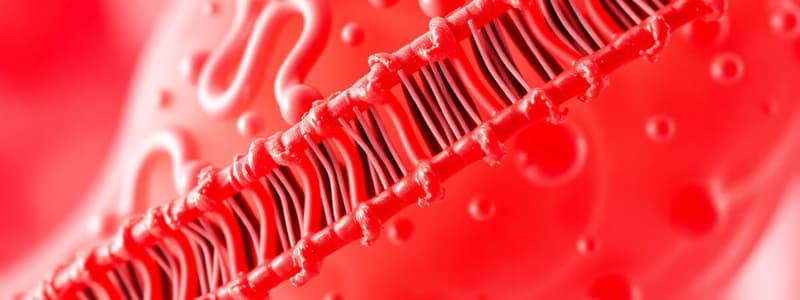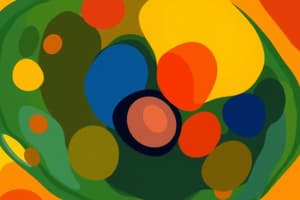Podcast
Questions and Answers
Compare and contrast the primary and secondary cell walls in plant cells, highlighting their compositional differences and functional implications for the plant.
Compare and contrast the primary and secondary cell walls in plant cells, highlighting their compositional differences and functional implications for the plant.
Primary cell walls, made of cellulose, allow growth and flexibility. Secondary cell walls, containing lignin, provide increased rigidity.
Explain how the structure of the phospholipid bilayer determines the selective permeability of the cell membrane.
Explain how the structure of the phospholipid bilayer determines the selective permeability of the cell membrane.
The hydrophilic heads face outward, while the hydrophobic tails face inward, creating a barrier that only allows certain molecules to pass through.
Describe the role of glycoproteins in cellular communication and the immune response.
Describe the role of glycoproteins in cellular communication and the immune response.
Glycoproteins help cells recognize each other and play a role in the immune system.
How do enzymes facilitate biochemical reactions, and what is the significance of the active site in this process?
How do enzymes facilitate biochemical reactions, and what is the significance of the active site in this process?
Contrast competitive and non-competitive inhibition, explaining how each affects enzyme activity.
Contrast competitive and non-competitive inhibition, explaining how each affects enzyme activity.
Explain how the coordinated action of photosynthesis and respiration maintains the flow of energy and cycling of carbon in ecosystems.
Explain how the coordinated action of photosynthesis and respiration maintains the flow of energy and cycling of carbon in ecosystems.
Describe the role of ATP in cellular processes, and explain how the molecule releases energy when needed by the cell.
Describe the role of ATP in cellular processes, and explain how the molecule releases energy when needed by the cell.
Compare and contrast the functions of mitochondria and chloroplasts in eukaryotic cells.
Compare and contrast the functions of mitochondria and chloroplasts in eukaryotic cells.
Describe the roles of tight, adherens, and gap junctions in maintaining tissue integrity and facilitating intercellular communication.
Describe the roles of tight, adherens, and gap junctions in maintaining tissue integrity and facilitating intercellular communication.
Compare and contrast diffusion, osmosis, and active transport, noting what distinguishes each, and providing relevant examples.
Compare and contrast diffusion, osmosis, and active transport, noting what distinguishes each, and providing relevant examples.
Flashcards
Prokaryotes
Prokaryotes
Smaller, simpler cells without a nucleus. E.g. Bacteria
Eukaryotes
Eukaryotes
More complex and larger cells that contain a nucleus and other complex organelles.
Phospholipid Bilayer
Phospholipid Bilayer
A double layer of phospholipid molecules arranged with hydrophilic heads facing outward and hydrophobic tails facing inward. Regulates what enters & exits.
Tight Junctions
Tight Junctions
Signup and view all the flashcards
Adherens Junctions
Adherens Junctions
Signup and view all the flashcards
Organelles
Organelles
Signup and view all the flashcards
Nucleus
Nucleus
Signup and view all the flashcards
Mitochondria
Mitochondria
Signup and view all the flashcards
Potential Energy
Potential Energy
Signup and view all the flashcards
Kinetic Energy
Kinetic Energy
Signup and view all the flashcards
Study Notes
- Prokaryotic cells are smaller and simpler, lacking a nucleus.
- Eukaryotic cells are more complex and larger, and contain a nucleus.
- All cells share the following components: plasma membrane, cytoplasm, DNA, and ribosomes.
- The cell membrane comprises a phospholipid bilayer and regulates the entry and exit of substances.
- The cell membrane regulates what enters and exits the cell by way of a selectively permeable barrier.
Cell Membrane Proteins
- Integral proteins aid in molecule transport in and out of the cell.
- Peripheral proteins facilitate communication, influence cell shape, and accelerate reactions.
- Channel proteins allow specific molecules to pass through without energy expenditure.
- Carrier proteins transport molecules in or out, sometimes using energy.
- Receptor proteins receive signals and trigger responses within the cell.
- Glycoproteins help cells recognize each other and participate in the immune system.
Cell Walls
- Primary cell walls constitute the initial layer in plant cells.
- Primary Cell walls facilitate growth and flexibility with a cellulose composition.
- Secondary cell walls are inside the primary wall, offering additional rigidity with components like lignin.
- Middle lamella, a pectin layer, glues adjacent plant cells together.
- Gram-positive bacteria possess a thick peptidoglycan layer, influencing their Gram staining properties.
- Gram-negative bacteria have a thinner peptidoglycan layer and an additional outer membrane of increased complexity.
Organelles and Functions
- Organelles are specialized structures within a cell, each performing a specific function.
- The Nucleus stores DNA and coordinates cellular activities like growth and reproduction and is considered the "brain" of the cell.
- Mitochondria produce cellular energy through cellular respiration.
- Ribosomes are responsible for protein synthesis.
- The Endoplasmic Reticulum (ER) is a membrane network involved in protein and lipid synthesis; rough ER contains ribosomes, while smooth ER does not
- The Golgi Apparatus modifies, sorts, and packages proteins for secretion.
- Lysosomes contain digestive enzymes that break down waste and worn-out cell parts.
- Vacuoles store water, nutrients, and waste products, being particularly prominent in plant cells.
- The Cell Membrane separates the cell from its environment, thus controlling what enters and exits
- The Cytoplasm is the jelly-like substance within the cell where many cellular processes occur.
- Centrioles organize microtubules during mitosis for cell division.
- Mitochondria and chloroplasts both contain ribosomes.
Cell Junctions
- Tight junctions form a continuous seal between cells, preventing leakage, crucial in tissues like the intestines or bladder.
- Adherens junctions provide strong cell-to-cell adhesion, important for tissues experiencing mechanical stress like skin and muscle.
- Desmosomes are specialized adherens junctions with strong spot-like connections, especially important in high-tensile strength tissues like the epidermis.
- Gap junctions create small channels for direct exchange of ions and molecules between cells, crucial for coordinated activity in tissues like cardiac muscle.
Cytoskeleton
- Microfilaments (actin filaments) aid in cell movement, shape, and division, important for processes like muscle contraction.
- Intermediate filaments provide strength and stability, helping the cell resist stress and maintain its shape.
- Microtubules act like tracks for moving things around the cell and are important during cell division to separate chromosomes.
Energy
- Potential energy is stored energy due to an object's position or condition.
- Kinetic energy is energy an object has because of its motion.
- Potential energy is stored energy, while kinetic energy is energy in motion.
- Electrons transfer energy as they move.
- When electrons move in a circuit, such as a battery or wire, they transfer energy to generate electricity.
- Oxidation is the process of losing electrons.
- Reduction is the process of gaining electrons.
- ATP is the main energy source for cells, storing energy in the bond between its second and third phosphate groups.
- ATP is converted to ADP when a cell needs energy by breaking off the third phosphate group.
- ATP functions as a charged battery, releasing energy upon losing a phosphate.
- The sun is the primary energy source.
- Photosynthesis produces glucose and oxygen, while respiration uses glucose and oxygen to release energy.
- Carbon dioxide from respiration is used in photosynthesis, forming a cycle.
Photosynthesis and Respiration
- Photosynthesis: carbon dioxide, water, and light energy
- Respiration: glucose and oxygen
Enzymes
- Enzymes are proteins made of amino acids
- The active site is part of the enzyme where the substrate binds.
- It can be likened to a “lock”, and the substrate the “key”.
- Enzymes are proteins with an active site that speed up reactions by lowering the energy needed.
- Active site is where the enzyme works.
- Competitive inhibition blocks the active site.
- Non-competitive inhibition changes the enzyme shape.
Transport
- Diffusion involves molecules moving from high to low concentration without energy.
- Osmosis involves water moving through a membrane from low to high solute concentration without energy.
- Active transport involves molecules moving against their concentration gradient, requiring energy (ATP).
- Endocytosis is when the cell engulfs large molecules, requiring energy.
- Exocytosis is when the cell releases large molecules by merging a vesicle with the membrane, requiring energy.
Studying That Suits You
Use AI to generate personalized quizzes and flashcards to suit your learning preferences.




